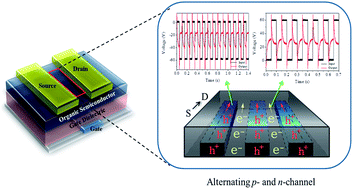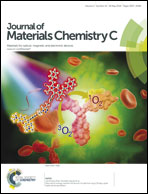An organic microcrystal array-embedded layer: highly directional alternating p- and n-channels for ambipolar transistors and inverters†
Abstract
An organic microcrystal array-embedded active layer for highly directional alternate p- and n-channels is prepared for fabricating a high-performance ambipolar organic field-effect transistor (OFET) and complementary inverter by successive deposition of p- and n-channel organic semiconductors on a polymeric gate dielectric. First, a microcrystal array of 6,13-bis(triisopropylsilylethynyl)pentacene (TIPS-pentacene, p-channel) is directly grown over the gate dielectric, and then a copper hexadecafluorophthalocyanine (F16CuPc) layer is formed by a thermal evaporation method, resulting in the formation of an organic microcrystal array-embedded active layer with highly directional alternating n- and p-channels between the source and drain electrodes. Devices based on this active layer exhibited clear ambipolar charge transport characteristics with high ambipolarity (>90%). The ambipolar charge transport mechanism is discussed in detail. In addition, air-stable complementary inverters comprising two ambipolar OFETs are also demonstrated.


 Please wait while we load your content...
Please wait while we load your content...